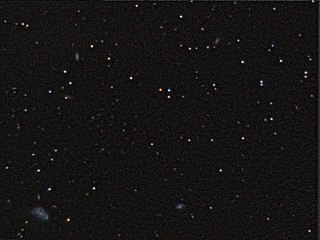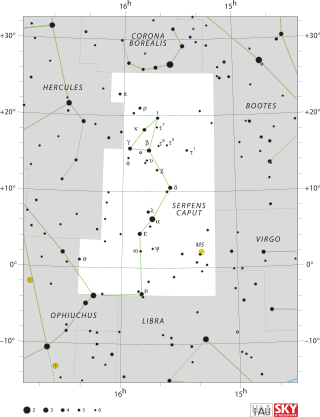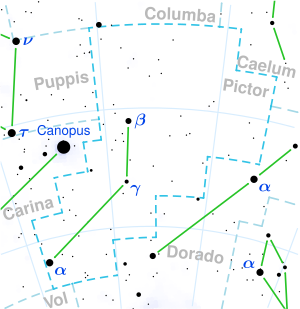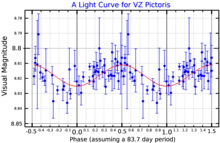
Teegarden's Star is an M-type red dwarf in the constellation Aries, 12.5 light-years from the Solar System. Although it is near Earth it is a dim magnitude 15 and can only be seen through large telescopes. This star was found to have a very large proper motion of about 5 arcseconds per year. Only seven stars with such large proper motions are currently known. Teegarden's Star hosts a planetary system with at least three planets.

Wolf 359 is a red dwarf star located in the constellation Leo, near the ecliptic. At a distance of 7.86 light-years from Earth, it has an apparent magnitude of 13.54 and can only be seen with a large telescope. Wolf 359 is one of the nearest stars to the Sun; only the Alpha Centauri system, Barnard's Star, and the brown dwarfs Luhman 16 and WISE 0855−0714 are known to be closer. Its proximity to Earth has led to its mention in several works of fiction.

54 Piscium is an orange dwarf star approximately 36 light-years away in the constellation of Pisces. In 2003, an extrasolar planet was confirmed to be orbiting the star, and in 2006, a brown dwarf was also discovered orbiting it.
HD 147513 is a star in the southern constellation of Scorpius. It was first catalogued by Italian astronomer Piazzi in his star catalogue as "XVI 55". With an apparent magnitude of 5.38, according to the Bortle scale it is visible to the naked eye from suburban skies. Based upon stellar parallax measurements by the Hipparcos spacecraft, HD 147513 lies some 42 light years from the Sun.
HD 130322 is a star with a close orbiting exoplanet in the constellation of Virgo. The distance to this system is 104 light years, as determined using parallax measurements. It is drifting closer to the Sun with a radial velocity of −12.4 km/s. With an apparent visual magnitude of 8.04, it is too dim to be visible to the naked eye; requiring binoculars or a small telescope to view. Being almost exactly on the celestial equator the star is visible everywhere in the world except for the North Pole. The star shows a high proper motion, traversing the celestial sphere at an angular rate of 0.197 arcsec yr−1.
HD 69830 is a yellow dwarf star located 41.0 light-years away in the constellation of Puppis. In 2005, the Spitzer Space Telescope discovered a narrow ring of warm debris orbiting the star. The debris ring contains substantially more dust than the Solar System's asteroid belt. In 2006, three extrasolar planets with minimum masses comparable to Neptune were confirmed in orbit around the star, located interior to the debris ring.

Lambda Serpentis, Latinized from λ Serpentis, is a star in the constellation Serpens, in its head. It has an apparent visual magnitude of 4.43, making it visible to the naked eye. Based upon parallax measurements, this star lies at a distance of about 38.9 light-years from Earth. Lambda Serpentis is moving toward the Solar System with a radial velocity of 66.4 km s−1. In about 166,000 years, this system will make its closest approach of the Sun at a distance of 7.371 ± 0.258 light-years, before moving away thereafter.

Gamma Delphini, which is Latinized from γ Delphini, is a wide binary star system in the northern constellation of Delphinus. The star marks one corner of the asterism "Job's Coffin". The pair can be split with a modest amateur telescope and have been described as "one of the prettier pairs in the sky", with their contrasting colors said to be orange and lime in appearance. Together, the system is visible to the naked eye with a combined apparent visual magnitude of 3.87.

Gliese 667 is a triple-star system in the constellation Scorpius lying at a distance of about 7.2 parsecs from Earth. All three of the stars have masses smaller than the Sun. There is a 12th-magnitude star close to the other three, but it is not gravitationally bound to the system. To the naked eye, the system appears to be a single faint star of magnitude 5.89.
23 Librae is a star in the zodiac constellation Libra, making it visible from most of the Earth's surface. With an apparent visual magnitude of 6.45, it requires dark skies and good seeing conditions to see this star with the naked eye. It has a planetary system with two confirmed extrasolar planets.
94 Ceti is a trinary star system approximately 73 light-years away in the constellation Cetus.
12 Ophiuchi is a variable star in the constellation Ophiuchus. No companions have yet been detected in orbit around this star, and it remains uncertain whether or not it possesses a dust ring.
HD 11964 is a binary star system located 110 light-years away from the Sun in the equatorial constellation of Cetus. It is visible in binoculars or a telescope but is too faint to be seen with the naked eye, having an apparent visual magnitude of 7.51. The system is drifting closer to the Sun with a radial velocity of −9 km/s. Two extrasolar planets have been confirmed to orbit the primary.
Gliese 412 is a pair of stars that share a common proper motion through space and are thought to form a binary star system. The pair have an angular separation of 31.4″ at a position angle of 126.1°. They are located 15.8 light-years distant from the Sun in the constellation Ursa Major. Both components are relatively dim red dwarf stars.
HD 222582 is a multiple star system in the equatorial constellation of Aquarius. It is invisible to the naked eye with an apparent visual magnitude of 7.7, but can be viewed with binoculars or a small telescope. The system is located at a distance of 137 light years from the Sun based on parallax, and it is drifting further away with a radial velocity of +12 km/s. It is located close enough to the ecliptic that it is subject to lunar occultations.
Gliese 176 is a small star with an orbiting exoplanet in the constellation of Taurus. With an apparent visual magnitude of 9.95, it is too faint to be visible to the naked eye. It is located at a distance of 30.9 light years based on parallax measurements, and is drifting further away with a heliocentric radial velocity of 26.4 km/s.
Gliese 521 is a double star in the northern constellation of Canes Venatici. The system is located at a distance of 43.6 light-years from the Sun based on parallax measurements, but is drawing closer with a radial velocity of −65.6 km/s. It is predicted to come as close as 15.70 light-years from the Sun in 176,900 years. This star is too faint to be visible to the naked eye, having an apparent visual magnitude of +10.26 and an absolute magnitude of 10.24.
HD 168009 is a star in the northern constellation of Lyra. It has an apparent visual magnitude of 6.3, placing it just above to below the normal limit of stars visible to the naked eye under good viewing conditions of 6-6.5. An annual parallax shift of 42.93 mas provides a distance estimate of 76 light years. It is moving closer to the Sun with a heliocentric radial velocity of −65 km/s. In about 328,000 years from now, the star will make its closest approach at a distance of around 17 ly (5.1 pc).
HD 146389, is a star with a yellow-white hue in the northern constellation of Hercules. The star was given the formal name Irena by the International Astronomical Union in January 2020. It is invisible to the naked eye with an apparent visual magnitude of 9.4 The star is located at a distance of approximately 446 light years from the Sun based on parallax, but is drifting closer with a radial velocity of −9 km/s. The star is known to host one exoplanet, designated WASP-38b or formally named 'Iztok'.









